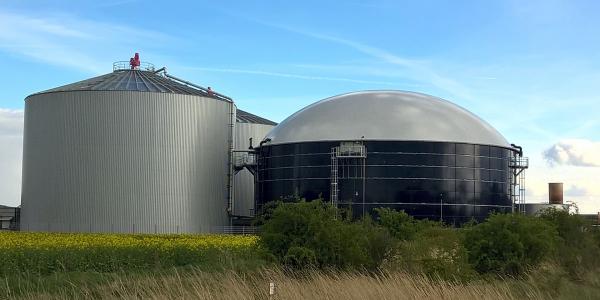Sebastian Bleschke
Geschäftsführer
Contact:
+49 30 36418 086
info@erdgasspeicher.de


Renewable or green gas is an energy carrier produced from renewable energy sources. On the one hand, there is biogas derived in a fermentation process from biomass. On the other hand, there is hydrogen or synthetical methane which is manufactured via the Power-to-Gas technology.
The gas infrastructure and especially gas storage facilities are a crucial source of flexibility for the future energy system. To tap the full potential of these infrastructures for the energy transition, we need renewable gases.
Renewable or green gases are already used within the gas infrastructure today. In 2017 about 9 terawatt hours of biogas were injected into the German gas pipeline grid. Moreover, about 8 per cent of renewable electricity in Germany is produced from Biogas, supplying to more than 8 million customers. As opposed to wind and solar power, biogas can provide electricity at all times.
Green hydrogen produced in Power-to-Gas facilities is also injected in to the gas pipeline grid. Normal gas grids can only tolerate about 10 per cent of hydrogen. But this may not be the end of the story. Pilot projects testing a 20 per cent hydrogen share are already in the pipeline.
Many studies have shown the advantages of using green gases on the way towards a carbon-neutral society. But what kind of green gas does even exist? In general, there are two kinds: Firstly, there is biogas which is produced from biomass in the fermentation process. Secondly, there are renewable gases such as hydrogen or synthetical methane produced via the Power-to-Gas technology.
Biogas is produced from organic waste, for example, from high-energy plants such as corn or rapeseed, but also from manure. When these substances are decomposed, a gas mixture is formed. In addition to the natural air constituents carbon dioxide, oxygen and nitrogen, this primarily contains methane, which, as a fuel, has the same properties as natural gas. Depending on which substances are used in the production, the biogas has a methane share of 50 to 65 percent.
Of course, the production of biogas does not happen by accident. On the contrary, the organic raw materials are airtight sealed and fermented in biogas plants. The fermentation tanks are also called fermenters.
Energy generation via biogas is almost CO2-neutral, as the CO2 produced during combustion remains in the natural carbon cycle. This means that the released carbon dioxide is bound during the its lifetime by the next plant generation, which is then used for the biogas production. In addition, the gas-fermented material is later used as a high-quality fertilizer.

Hydrogen is an invisible, odorless and non-toxic gas. As an energy source, hydrogen does not produce any harmful emissions when burned. However, in its pure form, hydrogen does not occur in nature. It must therefore be manufactured artificially in technical processes.
Fortunately, hydrogen can be produced on a large scale using renewable energy. The power-to-gas technology serves this purpose. Renewable electricity, for example from wind or solar plants, is used for a so-called electrolysis process. The electrolysis separates water into its components oxygen and hydrogen using small electrical conductors, the electrolytes. The positively charged hydrogen moves to the negative pole (cathode), the negatively charged oxygen of the water to the positive pole (anode). Thus, hydrogen can be obtained as an energy source.
However, hydrogen also presents difficulties as an energy carrier. On the one hand, hydrogen is a light gas and therefore has an enormous volume. Thus, hydrogen needs a lot of space to be stored. To match one liter of gasoline, for example, you need 12 cubic meters of uncompressed hydrogen. In addition, both in the recovery of hydrogen as well as in the reconversion process, energy is lost in the form of waste heat.
The experts of the gas industry are working intensively on both problems. Gas storage will also play a crucial role in the storage of hydrogen. In various projects, companies are currently researching to what extent existing porous and cavern storage systems can be converted to store this renewable gas.
If the first results of research on the efficiency of German gas storage facilities are to be extrapolated, it can be assumed that with hydrogen already at least 24 gigawatts of secured renewable energy can be offered from gas storage facilities. Altogether, that is energetically a quarter of the peak load of the electricity market in Germany. The gas storage industry is thus getting ready for a completely renewable world.
Synthetic gases are a product of further developed hydrogen that was produced with power-to-gas. Synthetic methane is produced in the process of methanation. In this process, the hydrogen initially obtained by electrolysis is mixed with carbon dioxide. The gas mixture then goes through a chemical process with synthetic methane being the outcome. Synthetic methane is identical to fossil natural gas and renewable biogas (CH4).
Since carbon dioxide, i.e. CO2, is required to produce synthetic methane, the question arises as to the origin of the CO2. Synthetic methane is only a renewable energy source if it really avoids CO2 emissions and not just relocates them. If the synthetic gas is produced with industrial emissions, for example, then the climate-damaging emission merely shifts to a later date. Uniper, for example, uses CO2 from a biofuel plant at its power-to-gas plant in Falkenhagen, Brandenburg. Several companies are already working on how to extract CO2 from the air.
Because synthetic methane has the same chemical properties as natural gas, it can be used in many ways without any problems – wherever fossil natural gas is currently used. Thus, it serves as a fuel in traffic, to generate heat and as feedstock for large power plants. For end users who already rely on natural gas technologies in their homes, nothing will change with the use of synthetic gas. Synthetic methane can also be absorbed in gas networks and gas storage facilities without limitation.

Sebastian Bleschke
Geschäftsführer
Contact:
+49 30 36418 086
info@erdgasspeicher.de